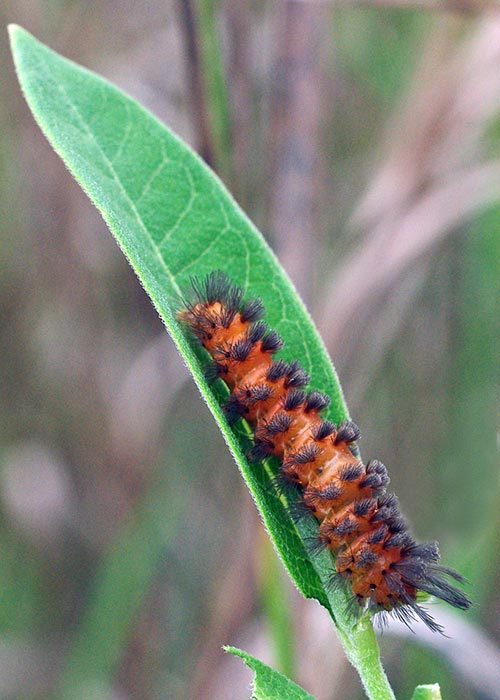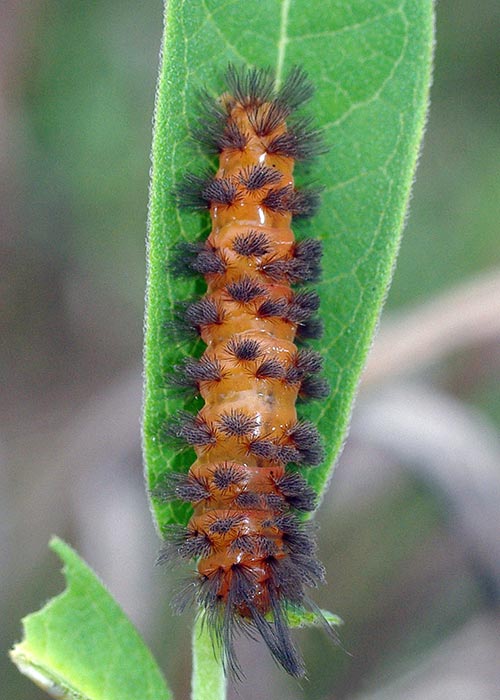Salutations, BugFans,
Recently, the BugLady fielded an email from a woman in a nearby village asking for an ID of a caterpillar she had photographed in her suburban yard last summer. The BugLady found out who the caterpillar was, but she had a niggling feeling that she had photographed and misidentified this odd-looking larva, and both turned out to be true. The next question was “where?” She browsed through some other pictures she had taken the same day in 2011 and decided that she had photographed it on the prairie at Riveredge Nature Center.
The Unexpected Cycnia
What a dynamite name for this moth in the Tiger and Lichen moth family Erebidae (formerly part of the family Arctiidae)! The UC (Cycnia inopinatus) (inopinatus being Latin for unexpected or surprising) is found in the U.S. east of the Great Plains into Massachusetts, and south into Mexico. Sources say that it prefers “high quality coastal scrub (including the Great Lakes drainage), dry, oak barrens, and similar native grasslands, typically on sand.” Its populations are described as “rare and local.” In fact, according to a 2005 USDA Forest Service report called Conservation Assessment for the unexpected tiger moth (Cycnia inopinatus (Edwards)), “It is never common (except on a very local level) and most states contain only one or a few populations.” The UC’s status in Wisconsin is listed as S2S3: (S2 – rare or uncommon; S3 – imperiled because of rarity.
Once established in their rather specialized habitats, UCs tend to stay put, dispersing maybe several hundred yards during their adult lives. The exception is when a population takes advantage of a natural corridor lined with caterpillar food plants, like a railroad right-of-way.

Unexpected Cycnia Caterpillars
UC caterpillar food plants are various milkweeds, especially butterfly weed and whorled milkweed, but common milkweed, not so much. The theory is that the narrower-leaved species of milkweed contain higher concentrations of the cardenolide chemicals that form the basis of the caterpillars’ defense system (their dense hair is off-putting to predators, too). Like the monarch and the milkweed bug, the aposematically-colored UC caterpillars ingest toxins from milkweed and therefore are toxic themselves. Despite the poisons, UC caterpillars and pupae are eaten by birds, some rodents, spiders, and a few insects; and parasitic wasps and tachinid flies target the larvae in behalf of their parasitoid offspring.
The unobtrusive but subtly beautiful adults, pictured here and here, look very similar to the Dogbane tiger moth (Cycnia tenera) (but their caterpillars don’t resemble each other). Sogaard, in Moths and Caterpillars of the North Woods, notes that the male dogbane tiger moths “produce clicks (mostly ultrasonic but faintly audible to humans) in response to ultrasonic pulses from hunting bats, and in courtship,” and that “males release pheromones when near potential mates.” The BugLady assumes that the UC has these capabilities, too. Sogaard also notes that “Males deprived experimentally of both sound production and pheromones were shunned.” UC moths don’t migrate, don’t stray far from milkweeds, and probably don’t feed.

There may be two broods a year in this area, with adult flight periods in spring and late summer (the BugLady’s caterpillar was photographed in early September). Females deposit white eggs on milkweed stems and leaves; the eggs hatch and larvae feed for about a month, adding more hairs in each clump at each molt. An alarmed larva will drop off of a leaf to the ground and hustle through the thatch. The color of a caterpillar’s bristles can be pale or dark or in-between. Caterpillars form a pupal case on the ground.
The list of threats to the UC includes the usual suspects—loss/fragmentation of its once-widespread habitat due to agricultural clearing, grazing, development, and fire suppression (which allows normal succession of communities/habitats); competition from sun-loving invasive species like black locust; and exposure to a variety of often-non-specific pesticides that are used to control gypsy moths, agricultural pests and weeds. Ironically, the fires that once perpetuated its habitat threaten the moths, which overwinter as pupae in leaf litter below their old food plants, highly susceptible to controlled burns in winter and early spring.
In the course of her research, the BugLady came across the Monarch Lab website. Researchers at the Monarch Lab are interested in tracking the location of the UC, too, so if you find a caterpillar, please report them; remember to include the location of your sighting, and a photo would be grand.
The Bug Lady